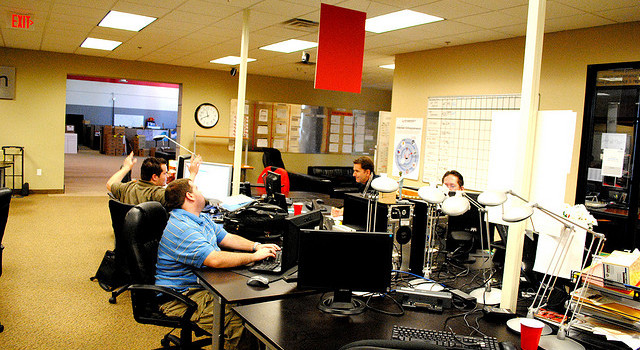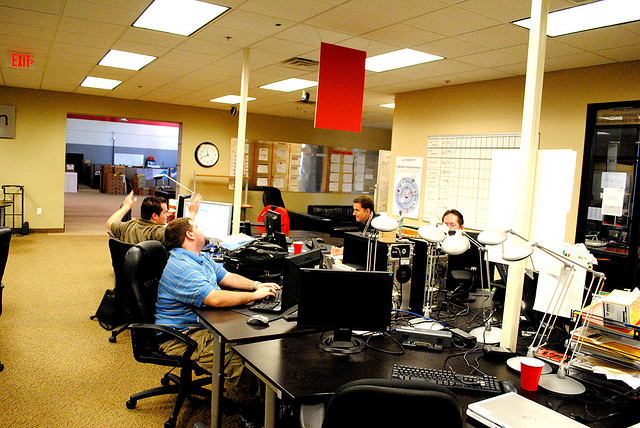7 Office Workouts To Reduce Muscle Pain

If you are a regular office employee and your job calls for long hours in the sitting posture, you must have experienced or are prone to sore muscles. According to latest research, improper posture during sitting is one of the major causative factors of back pain during routine working hours at office. Simple steps in the form of some basic workouts can prevent or reduce muscle pains in your body. The basic principles on which these workouts are performed, concentrate on strengthening of the over – stretched muscles and stretching the tight muscles. Here are 7 office workouts that will definitely help you in reducing muscular pains:
Photo by Infusionsoft Sales & Marke, CC BY-SA 2.0
1. Chin Tucks
To start with, staring at your computer screen and typing for 3-4 hours might seem to be a simple job, but it gradually leads to static posturing. The body develops a forward head posture in which the neck is bent forward, and shoulders and upper back become rounded towards the front of the body. Static posturing leads to fatigue of the neck and upper back muscles which have to continuously work like a crane to hold the weight of your head. In order to prevent this, frequent chin tuck exercises work well. With your head erect, pull your chin inwards by tucking your neck towards your throat. Listen to your body and whenever your neck muscles start feeling tired, tuck in your chin and break the cycle of static posturing.
2. Stabilization Of The Shoulder Blade
Trapezius is the large muscle which extends from the nape of the neck to the upper back. It is this muscle, along with other secondary muscles, which holds your neck in the upright position when you are sitting and performing reading, writing or typing work in your workstation. In your body, the shoulder girdle acts as a foundation for the neck. It includes the bones of your arm, collar bone and shoulder blade. Effective stabilisation of the shoulder blade reduces the risk of injury to the nerves and muscles of the neck. You can do these for your trapezius in your office:
- Shrug your shoulders upwards, hold them in the same position for 5 seconds, and then relax (Elevation).
- Pull your shoulders backwards so that your shoulder blades try to meet at the back and chest opens up (Retraction). Hold for 5 seconds and then relax.
- Rotate your shoulders starting from pulling them back, shrugging and then pushing them forwards (Rotation). The same action can be performed in the reverse sequence.
3. Stretch your neck and arm muscles
- During continuous sitting, our neck muscle named trapezius, tends to get tight. You can easily do a simple stretching exercise which involves sitting in a relaxed manner and bending your neck sideways, such that your ear tries to touch the shoulder. Hold your neck in this stretched pose for a 5-second pause and then bring it back to the midline. Do it on both sides.
- Before you log on to your computer in the morning and after logging off, stretch your wrist muscles by making a fist and rotating your wrists clockwise and anti-clockwise. You can also stretch your palm backwards with elbows straight to ease out the tension in the wrist and finger muscles.
4. Move And Stretch Your Low Back
Lunges in standing – As we sit in a slouched posture for hours together, our hip muscles tend to get tighter which disturbs the natural curves of our low back. Stretch the tight hip flexors in standing by performing the ‘Forward lunge’. Stand with one leg 1 foot ahead from the other. Now, keeping the hind leg straight, bend forwards slowly by bending the front leg knee. You should be able to feel the stretch on the front of thigh of the hind leg. Repeat this for both legs 10 times.
Unload your disc – Continuous sitting puts immense pressure on the disc, which is the cushion in between adjacent bones of our spinal column. Release the pressure by bending back and thrusting your pelvis in front in standing. You can also push up on the arms of your chair to ease your back.
5. Abdominal Tuck-Ins
Our spine is fit snugly between spinal muscles from the back and abdominal muscles from the front. For maintaining a healthy spine, it is inevitable to gain strength from both the front and back. The simplest way to keep our abdominals active is practicing tummy tucks. In the sitting position, concentrate on your belly button, pull it in, hold the contraction for about 5 seconds, and then relax. This exercise can be repeated whenever you are able to take an active break from work.
6. Deep Breathing Exercises
The importance of breathing cannot be over-emphasized to reduce stress. Deep breathing exercises during short breaks enhance relaxation and reduce mental stress. Sitting on your chair, close your eyes, concentrate on your breathing and take a relaxed deep breath in. Your upper abdomen should rise up. Then exhale and feel your chest moving in and abdomen going inwards. The tired body and mind can take advantage of this relaxing exercise and productivity can be boosted.
7. Intermittent Standing On Toes
Avoid prolonged sitting and static posturing on your chair. A short break in which you can stand on your toes and pump your calf muscles, improves circulation of the legs and eases the tensed back and neck muscles. Walking around for about 5 minutes can do the trick too.
Proper ergonomic education and simple steps of ‘working’ out your body during work can save you from unhealthy and detrimental effects on your body joints and overall physical well-being.
